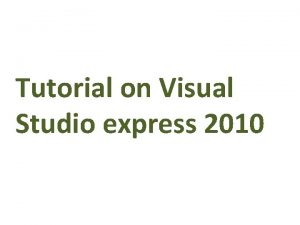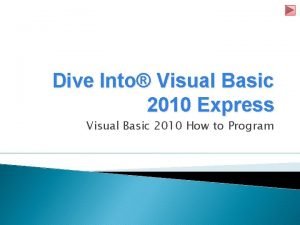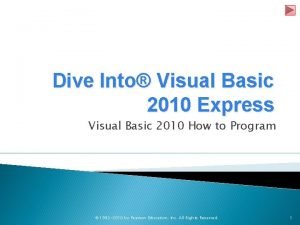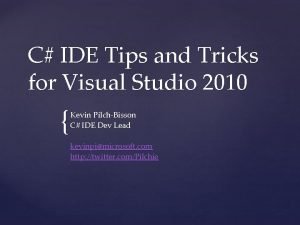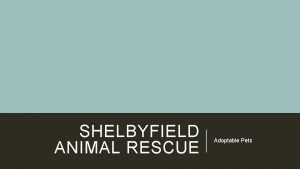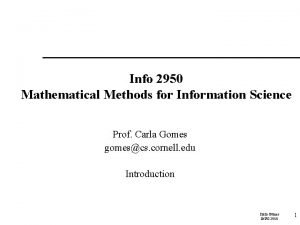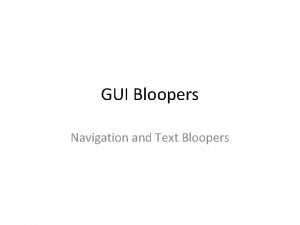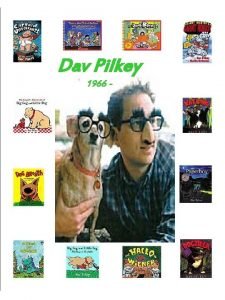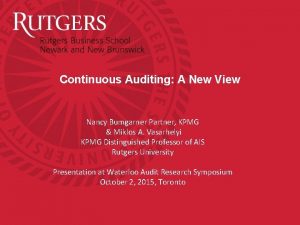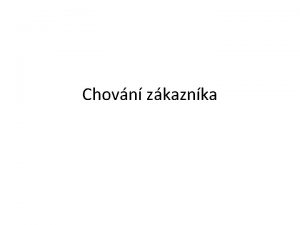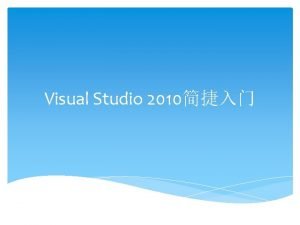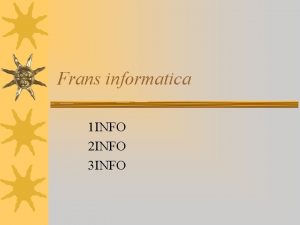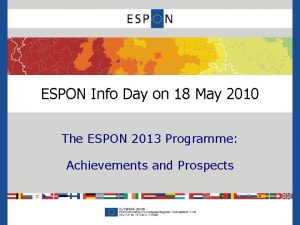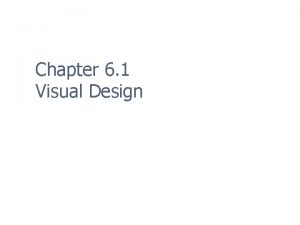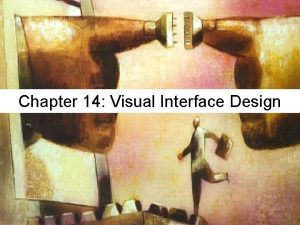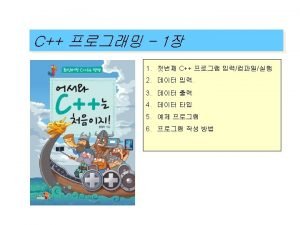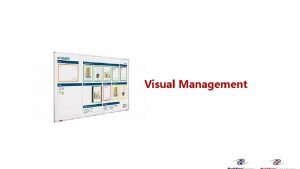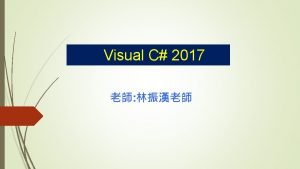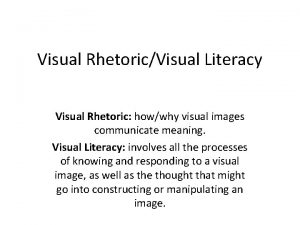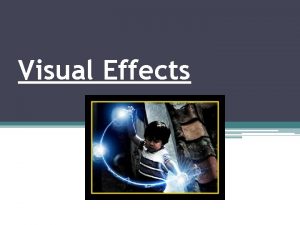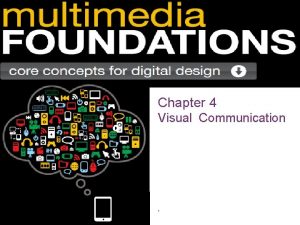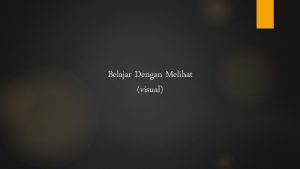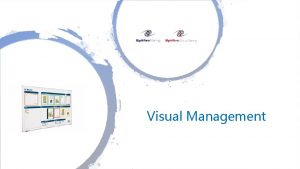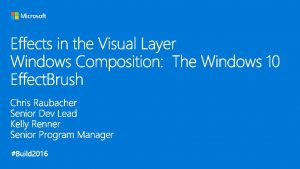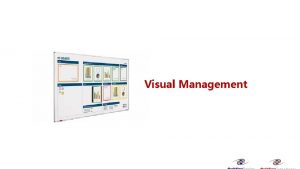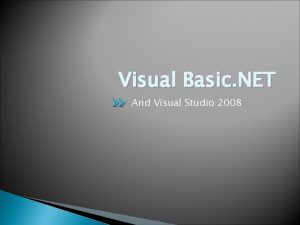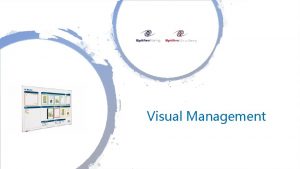Visual Design Info Design 12 May 2010 Visual
































- Slides: 32

Visual Design, Info Design 12 May 2010

Visual Design § Grid § Color § Typography

Visual Design : The Grid § A grid orders the elements on a page – whether the page is literal (paper) or figurative (a screen) § Paper (print) – size is known, fixed § Web (screen) – size is unknown, layout may be fixed or fluid

Visual Design : Golden Ratio (1/3) § The Golden Ratio (or the Divine Proportion, Golden Mean, Golden Rectangle, etc) is a visual representation of a number called Phi (pronounced fi) … it’s found throughout nature -in space, physics, DNA, math, art, architecture (see Greek or Egyptian works) § The Golden Ratio is a measurement between two segments of a whole. If line “A” has two unequal parts, “AB” and “BC” – the golden ratio, 1. 618 [actually 1. 618033988749895], is achieved where A/B = B/C

Visual Design : Golden Ratio (2/3) Source: Design and the Divine Proportion

Visual Design : Golden Ratio (3/3) Source: Design and the Divine Proportion

The Nautilus Shell Once you start splitting a golden rectangle by the ratio, you can keep sub-splitting it down forever. The spiral this produces exactly matches the growth of the Nautilus shell in nature. Source: Anyone for thirds?

Visual Design: Rule of Thirds § Simplified Golden Mean § Symmetrical design is, usually, boring. Most designs can be made more visually interesting by mentally dividing the area (page, photo) into thirds vertically and horizontally and placing the most important elements within those thirds. § Examples: photos 1, photos 2

Color Importance § 80% of the brain is devoted to processing visual information § The two categories: form and color

What is color? § The visual effect caused by the spectral composition of light which is emitted, transmitted or reflected by objects [Color Logic for Web Design, p 7] § The experience of color is always relative to context – relationship to adjacent color can cause noticeable differences in visual perception § See Color Perception (in 3000 Words) In William Bechtel and George Graham (eds), A Companion to Cognitive Science, Blackwells, 1998. http: //www. ucc. uconn. edu/~wwwphil/ccompan. html

Color Models § Sir Isaac Newton developed the first color wheel in 1666 § Computer monitors use additive color model : RGB § Projected light § Printers use subtractive color model : CMYK § Reflected light

Color – Three Primaries § Red: #ff 0000 or #f 00 in CSS § Blue: #0000 ff or #00 f in CSS § Yellow: #ffff 00 or #ff 0 in CSS

Color – The Secondaries § Orange: #ff 9900 or #f 90 in CSS § Green: #00 ff 00 or #0 f 0 in CSS § Purple: #ff 00 ff or #f 0 f in CSS

Color – The Tertiaries § Yellow-Orange: #ffcc 00 or #fc 0 in CSS § Red-Orange: #ff 6600 or #f 60 in CSS § Red-Purple: #cc 00 cc or #c 0 c in CSS § Blue-Purple: #9900 ff or #90 f in CSS § Blue-Green: #00 cccc or #0 cc in CSS § Yellow-Green: #ccff 00 or #cf 0 in CSS

Color Harmony § Analogous color: side-by-side on color wheel § Complementary color: opposites on the color wheel § Triads: where the points of an equilateral triangle touches the color wheel

Additive & Subtractive Color From http: //www. sanford-artedventures. com/study/g_color_wheel. html

Attributes § Hue – the specific color § Saturation – intensity § Value – brightness § Color Principles Lecture – Relative Value (Part 1, 11. 11)

Color Theory: Chevreul (1/2) French Chemist (1776 -1889) 1. Highly contrasting colors used in sufficient quantities will make each appear more brilliant; when used in small quantities the eye blends and creates a new, duller color.

Color Theory: Chevreul (2/2) 2. When colors are not analogous and not complementary, one will give the other a complementary tinge 3. Colors that are adjacent to one another tend to optically mix to create a new color

Color Theory: Bezold Effect § Changing only one color can significantly alter appearance

Color Theory: Albers (1/2) § Perceived hue will change based on surroundings; Bauhaus (1888 -1976) § Three colors below (and next) appear to be four L: r 102/g 102/b 104; R: r 153/051 g/153 b; C: r 153/g 102/b 204

Color Theory: Albers (2/2) L: r 153/g 204/b 000; R: r 204/255 g/153 b; C: r 051/g 204/b 102

Color Theory: Movement (1/2) § Depending on the background, warm colors tend to “advance” and cool colors “recede” § Thus, pick your colors for visited/not visited links with care § Also be aware of cultural meanings (green = “go” so might not be a good choice for “went”)

Color Theory: Movement (2/2) § Which color advances?

Harmonious Guidelines § Use a limited color palette § Experiment with harmonies – match with tone § Dynamic, strong contrast = edgy, attentiongetting, energizing § Subtle, low contrast = fluid, low key, sophisticated

Typography § The art of arranging type, designing type and modifying type glyphs. § Serif and sans serif § Limited web palette § Monitor inconsistencies § Readability § There is an optimum line width, and it is determined by the number of characters in the line. A general rule of thumb is 2– 3 alphabets or 52– 78 characters (including spaces).

Design Examples § URLGrey. Hot – navigation § Portfolio 1 – overall (see samples) § Portfolio 2 – grid, typography § Business – broken grid § Inspiration: Zen. Garden, Daily. Slurp (color)

Visual Design : Resources § Feeling Your Way Around Grids § Design Grids For Web Pages § Designing Blog Theme Templates

Color Resources § Choosing Effective Color Schemes § Why Color Matters § Tool: Color Harmony Chooser § Browser Safe Palette

Typographic Resources § Web Design is 95% Typography § The Elements of Typographic Style Applied To The Web § Five Steps To Better Typography

Recap: Genres (1/2) § Individually: § Find three sites that you believe best epitomize the genre you worked on last week. Feel free to develop a “sub-genre” – such as “news” as a subset of “media. ” Also, try to find at least one that categorically fits but visually breaks the genre. § Identify what “makes” this genre immediately self-apparent – regardless of entry point § Identify content types found in this genre

Recap: Genres (2/2) § Regroup– discuss – reach consensus. Try to agree on one or two example sites. What do they have in common? § Color? § Type? § Grid? § Page width?
 Visual studio 2010 training
Visual studio 2010 training Visual c express 2010
Visual c express 2010 Visual basic 2010 ide
Visual basic 2010 ide Visual 2010 express
Visual 2010 express Visual basic 2010 express registrierungsschlüssel
Visual basic 2010 express registrierungsschlüssel Visual studio online pricing
Visual studio online pricing Visual studio 2010 tips and tricks
Visual studio 2010 tips and tricks Hci patterns
Hci patterns Vce viscom study design
Vce viscom study design Pemrograman visual dan pemrograman konvensional
Pemrograman visual dan pemrograman konvensional Ratecompareresult.info
Ratecompareresult.info Http://belarustoday.info/?sid=4
Http://belarustoday.info/?sid=4 Sunexpress solar
Sunexpress solar Sdb student required info
Sdb student required info History-info sip header
History-info sip header History-info sip header
History-info sip header Dtmf sip info
Dtmf sip info Shelbyfield animal rescue
Shelbyfield animal rescue Game sheet info crossword clue
Game sheet info crossword clue Matrici informatica
Matrici informatica Ee.humanitarian response.info/x/vpdlixjf
Ee.humanitarian response.info/x/vpdlixjf Insarag
Insarag Info 2950 cornell
Info 2950 cornell Sanesfa.info
Sanesfa.info Text bloopers
Text bloopers Penryn info point
Penryn info point Statcalc epi info
Statcalc epi info Epi info 2000
Epi info 2000 Dav pilkey born
Dav pilkey born [email protected]
[email protected] Epi info 7
Epi info 7 Nancy bumgarner contact info
Nancy bumgarner contact info Halek info
Halek info

